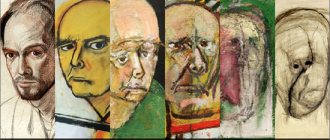Ocular migraine is one of the forms of ordinary migraine; in ophthalmology it is called “atrial scotoma”. This disease is accompanied by an unpleasant sensation of flickering, which is characterized by loss of visual fields. [toc] It also happens that the appearance of phosphenes occurs on the periphery of the blind zone, which in many cases is associated with a significant strengthening of the “ghost castle”. This visual sensation affects both eyes at once, which may indicate serious disorders occurring in some parts of the nervous system and in the visual analyzer itself.
Symptoms
The main symptoms of ocular migraine, which are almost painless, usually disappear within 20-30 minutes. But this condition can sometimes be combined with a regular migraine, as a result of poor circulation in the brain.
This serious anomaly may be the result of malfunctioning of the occipital cortex, which has nothing to do with the eyes and their elements (retina).
Sometimes ocular migraines cause nausea. This condition is a good reason for refusing to drive a vehicle. Scientists are confident that the disease is associated with serious changes in the arteries of the brain, but the essence of the pathology has not yet been fully studied.
Causes of the disease
Ocular migraine can be caused by serious neurological disorders of the brain. Therefore, in most cases it occurs due to heredity. But the following factors are also considered to be the cause of the development of the disease:
- change in weather conditions;
- frequent stressful emotional states;
- changing your usual diet and eating habits;
- frequent prolonged mental stress;
- development of hypoxia (lack of oxygen);
- influence of pulsating light;
- hypothermia or severe overheating of the body;
- taking certain medications;
- systematic sleep disturbance;
- presence of bad habits;
- serious hormonal imbalances in the body;
- development of brain diseases.
Migraine attacks are currently considered to be the result of a disorder of vasomotor regulation due to regional angiodystonia. The disease (with an aura of visual disturbances) is mainly caused by discirculation in part of the posterior cerebral artery. Moreover, its retinal form is directly related to transient retinal ischemia.
Atrial scotoma in the eyes: causes, symptoms and treatment of ocular migraine, when it ripples and flickers
Among ophthalmological diseases, a special place is occupied by such pathology as atrial scotoma.
The disease leads to the appearance of a so-called “blind spot”, due to which the picture that appears before a person’s eyes becomes incomplete.
In the article we will look at the features of this pathology, find out the causes of scotoma, its symptoms, and how to treat this unpleasant and dangerous disease.
Types of atrial scotoma in the eye
Atrial scotoma can be physiological or pathological. A scotoma of a physiological nature is observed when the patient’s vision is normal, but the level of perception of light rays is either reduced or completely absent in a certain area of the retina.
diagram of atrial scotoma
A disease of a pathological nature occurs when the functioning of the blood vessels in the brain is disrupted, as well as the activity of the visual pathways and centers. Medicines containing morphine can cause pupillary miosis.
The disease usually acquires a pathological nature as a result of head and eye injuries, as well as serious endocrine diseases.
Symptoms in adults: migraine, spots, flickering, like, aura
Most people in its initial stages simply do not notice the presence of this pathology. Accurate diagnosis of atrial scotoma is possible only with the help of highly sensitive medical devices. Indicators such as something flickering and rippling in the eye are not sufficient grounds to carry out expensive diagnostics.
And people come to the doctor about a gray or whitish spot that appears in their field of vision. In most cases, such a sign after diagnosis is atrial scotoma. The eye disease keratitis can develop as a result of fungal infections, mechanical injuries, and vascular diseases.
However, other signs of this disease can be noticed, they are especially pronounced if the scotoma appeared quite a long time ago. Symptoms of the pathology include:
- periodic clouding and darkening of the eyes;
- the appearance of flashing lightning, spots, and flying flies in the visibility zone;
- migraine headaches;
- regularly occurring nausea of unknown etiology;
- with advanced scotoma, strabismus is likely.
Ocular migraine has a characteristic symptom - the appearance of a luminous aura around objects falling out of sight. The so-called effect of the appearance of phosphenes. How to prevent eye cataracts can be found in our article.
If the disease is not treated promptly, scotoma can lead to optic nerve atrophy. The result is loss of vision.
Note that there is no pain with atrial scotoma.
Treatment
To cope with this pathology, it is necessary to first eliminate the cause that gave rise to it. So, if atrial scotoma arose as a result of nervous strain, taking appropriate sedatives and sedatives is indicated. You can take the well-known valerian or the more modern Novopassit - your doctor can advise you on the right medication.
It is also necessary to take medications that have a positive effect on cerebral circulation. These may be Emoxipin, Piracetam and their analogues.
Usually, for this disease, the main treatment is necessarily supplemented with an auxiliary, vitamin treatment. If there are appropriate indications for this, the following medications are prescribed:
- antispasmodics;
- vasodilators;
- anti-inflammatory;
- analgesics, etc.
In addition, it is important not to forget that giving up bad habits and good nutrition will help you get rid of this disease faster. What is mild hypermetropia, we recommend reading our article here.
First aid
Let's find out what to do when an attack of atrial scotoma begins.
So, first of all, a person should take a horizontal position in this. It is also important to calm down, preferably drink tea with chamomile or lemon. Useful for an attack of scotoma and coffee.
It is recommended to take nitroglycerin or validol (under the tongue). Also, to improve the condition, you can inhale Amyl Nitrite vapor (by wetting a cotton swab with medicinal liquid). How to treat purulent conjunctivitis in adults can be found here.
You can inhale amyl nitrite vapor for no more than two minutes.
Note that timely initiation of therapy leads in most cases to successful treatment of atrial scotoma.
During pregnancy
This symptom is most often observed by pregnant women in the first trimester. The reasons in this case are non-compliance with the daily routine, regimen, vitamin deficiency, poor nutrition, and overwork. It is rare that atrial scotoma accompanies a woman throughout pregnancy.
In this case, treating scotoma on your own is doubly dangerous, since we are also talking about the health of the fetus. Pregnant women are also prohibited from using any folk or home treatments.
General recommendations in this case are as follows:
- spend more time in the air, walk;
- minimize heavy physical activity;
- general strengthening exercises;
- minimum stress and worries.
Various non-traditional treatment methods such as acupuncture, reflexology, etc. are possible only with the approval of a doctor.
Complications
complete and partial scotoma
Atrial scotoma is a rather dangerous disease. And under no circumstances should you treat it yourself. In this way, you can only waste precious time, and never achieve a positive result.
Note that if treatment (adequate and professional) is not started on time, irreversible consequences are likely to develop. This:
- strabismus;
- retinal detachment;
- complete loss of vision.
In addition, in some cases, scotoma is a symptom of stroke, brain abscesses and tumors. In this case, the lack of timely treatment is especially dangerous and can even lead to death.
Types of ocular migraine
In ophthalmology, two types of ocular migraine are defined: retinal and ophthalmoplegic.
- Retinal. If this form is present, a paracentral or central scotoma is formed, which differs in size and shape. The prognosis does not exclude the development of complete blindness in both eyes. The duration of the visual aura during retinal ocular migraine is several minutes and it manifests itself as follows: an intensifying pulsating headache develops in the frontocular zone. If the pain is very severe, nausea and vomiting may occur.
- Ophthalmoplegic (Moebius disease). With this form, there is a disturbance in the functioning of the oculomotor nerve. Often there is ptosis (drooping) of the upper eyelid and disruption of the pupils. The ophthalmic form of migraine usually manifests itself in the form of paralysis of the muscles around the eye.
What is the danger of the disease?
Ocular migraine in most cases does not pose a danger to the visual apparatus and the body as a whole; all visual functions are restored within 1 hour. However, an acute attack significantly worsens a person’s quality of life, often accompanied by throbbing pain, nausea and vomiting. And in some forms, symptomatic manifestations can bother you for a long time. Complications with this disease usually do not occur.
If attacks are repeated regularly, vision loss is possible.
Author of the article: Kvasha Anastasia Pavlovna, specialist for the website glazalik.ru Share your experience and opinion in the comments.
Manifestation of ocular migraine
When a migraine occurs, there may be no pain symptoms as such.
Patients may notice slight disturbances in the visual perception of various objects, and the image may completely disappear from time to time. Some patients experience strabismus and double vision.
A person begins to see objects not clearly enough, they seem to flicker, sometimes they can have a light effect. Such signs are not long-lasting and usually disappear within 20-30 minutes.
Basically, the symptoms of ocular migraine are individual for each person, because they consist only of visual pathologies. General symptoms may also be observed, among which is the appearance of a bright dotted spot in the field of vision (which may increase over time).
More rare manifestations
Sometimes there are attacks of severe throbbing headaches that can last for six hours. Initially, severe pain may be mild, but gradually it intensifies.
Patients often experience vomiting or nausea. Therefore, in most cases, such rare ocular migraines are associated with severe distortion of vision, and not with the appearance of pain.
The disease is also called migraine with aura (aura - sparks, rare flashes of light that appear in the eyes). Complete loss of vision in a specific area may occur, and part of the overall field of vision disappears from view.
The aura ceases to appear as a result of the onset of a throbbing headache, which is accompanied by nausea or vomiting. Among the rarer manifestations of ocular migraine or scintillating scotoma is the appearance of bright zigzag lines in front of the eyes, even when they are closed.
Is ocular migraine dangerous, how to identify and treat it?
With the tightening of the daily rhythm, an increasing burden of problems falls on a person. People increasingly began to complain of headaches, considering migraines to be their usual companion in life. But it happens that during a headache you can go blind for a while. This is how ocular migraine manifests itself.
Definition
Ocular migraine, also called scintillating scotoma, is a sudden onset of visual impairment. At the height of a headache attack, visual disturbances appear, which disappear over time.
Reasons and factors
The main causes of ophthalmic or visual migraine are not eye problems, but neurological ones. They are connected to the vessels of the brain in the area that is responsible for vision. This is predominantly the occipital region.
Before examining why this or that type of ocular migraine develops, let’s consider the general factors of its development:
- existing disorders in the vessels of the brain (underdevelopment, developmental anomalies, aneurysms);
- physical and emotional fatigue;
- imbalance of hormone levels;
- smoking, including hookah;
- food rich in spicy seasonings, smoked meats, alcoholic drinks, chocolate;
- flickering screen, light;
- pungent odors;
- loud noises;
- change of time zones, body biorhythm, lack of sleep.
All of the above becomes a trigger for ocular migraine if the body already has a background of the disease.
Symptoms and periods
Ocular migraine is a separate disease, and not just a symptom, and therefore has certain periods of its occurrence.
This is a prodrome, an aura, which is usually, but not always, followed by a migraine attack, which ends with a post-migraine period (resolution of the attack).
Prodrome
The initial period of migraine develops before the attack; these are its first symptoms. It manifests itself:
- lability of mood (depression, drowsiness, excessive irritability, cheerfulness);
- changes in well-being from increased activity to apathy;
- muscle pain;
- disorders of the gastrointestinal tract (stool upset, nausea, vomiting);
- increased thirst, increased urination.
Each person, depending on his type of nervous system and the functioning of the body, will have his own symptoms.
Aura
The second period manifests itself in the form of an aura, if we talk about the classical form. About 25% of people suffering from this disease have it. An aura is a symptom or a group of them that can be used to tell that an attack will soon occur.
Its most common type is a visual aura. The duration of the precursors ranges from a couple of seconds to half an hour, after which a migraine attack appears. Sometimes there may be no headache. This form is called “decapitated migraine.”
You can tell that you have developed a visual aura by the following signs:
- you see flashing flies, lines, zigzags or dots in front of you - these are phosphenes;
- flashes of light appear - photopsia;
- dark areas or spots before the eyes - scotomas;
- objects have changed size - Alice syndrome;
- you cannot see in some areas, for example near the nose or outside in both eyes - hemianopsia;
- vision has become narrow, the feeling that you are looking through a telescope - tubular vision syndrome.
These are also signs of ocular migraine if they appear not before, but during the headache.
Watch the video to see how a migraine aura manifests itself:
Migraine attack
The period of headache in severe cases can take three days. As a rule, pain is localized in one half of the head. The pain is strong, throbbing, growing and intensifying with movement, the slightest irritant: light, noise, heat or cold.
Vomiting may occur during an attack. Migraine status is considered especially dangerous during a prolonged migraine attack. It can even lead to a stroke, as the blood supply to the vessels of the brain is disrupted.
Permission
The resolution phase is characterized by the gradual fading of migraine symptoms and restoration of function. For some time you will feel heaviness in the head, weakness, decreased appetite, blurred vision.
Atrial scotoma
When dysfunction of the blood supply to the occipital region occurs, the visual analyzer suffers. It is in the occipital cortex that visual signals are analyzed and an image is formed. It is fed by the posterior cerebral artery. If blood flow is blocked, this area of the brain does not process the nerve signals that come to it well.
This is why eye symptoms appear - dark blind spots near the center, closer to the periphery of the eye. People also describe flickering dots, which is where the disease gets its name.
Retinal migraine
Retinal or retinal migraine is difficult to diagnose, so it is considered a fairly rare form of all 18 existing types. Its appearance triggers a developing spasm of the central retinal artery due to an increase in serotonin levels.
The consequence of a decrease in blood flow in the retinal area is a violation of its functions. This area cannot correctly perceive light impulses, and a scotoma is formed. In this case, there can be several scotomas, merging, they lead to complete ocular blindness.
The criterion for this type of ocular migraine is the presence of two migraine attacks during or an hour after the visual impairment, always in only one eye. There should be no eye changes between attacks.
Ophthalmoplegic
A symptom of an ophthalmoplegic attack (Moebius disease) is a violation of the movement of the eyeball on the side of cephalgia. This occurs from a decrease in blood flow through the artery supplying the oculomotor nerve. Pupil dilation, divergent strabismus, and drooping of the upper eyelid develop.
If the trochlear or abducens nerve is affected, then double vision and convergent strabismus are added to the existing eye symptoms. When all the nerves are affected, the eye stops moving completely - plegia. Such symptoms may persist for up to several months, but they always pass.
Diagnostics
A neurologist together with an ophthalmologist will help to correctly diagnose the ophthalmic form of migraine, since it requires consultation of these two specialists. The list of diagnostic measures includes:
- neurological and ophthalmological (eye) examinations;
- collection of complaints, history (how it developed) of ocular migraine;
- magnetic resonance imaging - for differential diagnosis with stroke, tumors and other organic diseases of the brain;
- ophthalmoscopy - examination of the fundus of the eye, spasm of the retinal arteries is determined;
- angiography - study of blood flow through the vessels of the brain, a violation of blood flow in the occipital region is detected;
- perimetry is a method of studying peripheral vision that reveals the presence of missing areas of vision - ocular scotomas.
Additionally, we invite you to watch the video experiment. People agreed to try out a device that shows the condition of a person with migraine. Find out how migraine headaches affect vision and eyes.
Treatment of the disease
Ocular migraine requires its own treatment in each period, taking into account the severity:
- a mild degree can be treated with non-steroidal anti-inflammatory drugs - Ibuprofen, Ketoprofen, Analgin;
- moderate severity requires the use of combined drugs (“Pentalgin”, “Tetralgin”);
- severe degrees, especially migraine status, require observation by a neurologist in a hospital setting. Due to severe cephalalgia, drugs from the group of opioids and corticosteroids are administered. When used for a long time and the dosage is not followed, they become addictive.
In addition to painkillers, triptans are indicated. These are drugs that act on special receptors in the brain and are designed exclusively for the treatment of migraines. They are not effective for other types of headaches.
The most studied of this group is antimigraine. It begins to have an effect after half an hour, and when using a nasal spray - after 15 minutes. It must be remembered that only a doctor selects the dosage and group of the drug; taking them independently for ocular migraine can be dangerous.
Unconventional methods
You can find many traditional medicines on the Internet, but not all of them are safe. The following received good reviews:
- Acupuncture, with a competent approach, affects reflexogenic zones. Helps reduce the frequency of ocular migraine attacks, their severity, and normalizes hormonal balance.
- Massage has a restorative, relaxing effect and increases the body's resistance to stress.
- Phyto-, homeopathy (the drug "Spigelon", sedating herbal mixtures).
Complications and prognosis
Dangerous complications of migraine are its transition to a chronic form, migraine status and the development of stroke.
The prognosis of the disease is positive if you follow all prescribed medical measures, change your lifestyle, and change your reaction to stress.
Prevention
For the prevention of ocular migraine, an important criterion is the elimination of trigger factors, that is, non-drug methods come first.
The patient should change the lifestyle that led to the attacks, normalize hormonal levels, get a good night's sleep, if possible go to work during the day, adjust the diet, and eliminate alcohol and tobacco.
If the frequency of ocular migraine attacks has not decreased by half, then it is necessary to add drug therapy, which is taken for up to 6 months. After this period, a break is taken to cancel or reduce the dosage if the patient responds well.
Ocular migraine, despite the little-studied mechanism of its occurrence, is not a death sentence. If all recommendations are followed, good prognosis and dynamics in the course of the disease are noted.
Diagnostics
Standard diagnosis of a patient with vision problems includes a physical examination, medical history and instrumental examination. During a physical examination, the doctor performs the following steps:
- conducts an external examination of the eye;
- assesses the volume of eye movements;
- assesses the level of pupillary response.
During instrumental research, some procedures are carried out:
- ophthalmoscopy;
- computed tomography or MRI of brain vessels;
- visual field inspection.
Ocular migraine can also cause cerebral arteriovenous malformation, and its ophthalmoplegic form is usually caused by an arterial saccular aneurysm of the carotid artery. In the case of frequent and prolonged attacks, it is very difficult to treat it; one cannot do without consulting a neurologist.
Diagnosis of the disease
If a patient suspects that he is developing an ocular migraine, a visit to a neurologist and ophthalmologist should not be delayed. The disease is diagnosed using several methods:
- An ophthalmological examination, during which the volume of movement and activity of the eyeball, the reaction of the pupils are assessed, and the boundaries of the field of vision are determined.
- Computed or magnetic resonance imaging.
- Ophthalmoscopy, which allows you to examine the fundus of the eye from the inside.
The disorder may be associated with arteriovenous malformation of the brain. And an ocular, seemingly harmless migraine may turn out to be an alarming manifestation of Tolosa-Hunt disease, characterized by arterial diffuse dilation of the saccular form of the carotid artery.
Migraine treatment
The diagnosis of “ocular migraine” signals the presence of problems in the central nervous system, and not in pathology and damage to the eye. In case of acute attacks, patients are prescribed a therapeutic course.
Before starting treatment, it is necessary to identify certain provoking factors and try to eliminate them. A full course of therapy can be prescribed by the attending physician only after confirmation of the diagnosis.
Treatment involves a complete change in lifestyle, adherence to rules throughout the day, physical activity and proper nutrition. In addition, patients may be prescribed special medications to help strengthen and quickly restore the functioning of blood vessels, organs of vision and the brain.
Most often, the attack goes away on its own after some time. To relieve pain when an attack occurs, you must do the following:
- lie down for a while in a cool, darkened room to relieve eye strain from bright light;
- when an attack occurs, start taking anti-inflammatory drugs;
- You can massage the collar area to stop the progressive symptoms of pain;
- when an attack occurs, you can take medications such as Sedalgin, Paracetamol, Ibuprofen - they will also have a significant analgesic effect;
- Among the common means of traditional medicine, strong sweet tea with raspberries can be called effective; rubbing balms with a high mint content into the temple area (Doctor Mom, “Zvezdochka”, etc.) will be no less effective;
- to relieve pain, you can also use a validol tablet, but only if there are no contraindications for taking it.
We can conclude that the treatment of ocular migraine directly depends on the correct diagnosis and the professional provision of qualified assistance from doctors.
That is why, when the first suspicious symptoms appear, you need to consult an ophthalmologist and undergo an examination, because atrial scotoma is in some cases a rather dangerous disease.
Atrial scotoma can easily disappear when the underlying causes of the disease are completely eliminated. In many cases, treatment of the disease comes down to complete restoration of the nervous system.
The appearance of migraine is extremely difficult to predict; it occurs suddenly, so it would be better to ease attacks with the help of special preventive procedures.
Diagnosis and treatment
If signs of ocular migraine appear, you should consult an ophthalmologist. During an attack, no changes in the structure of the eye are detected during ophthalmoscopy.
Read in a separate article: Marcus Gunn syndrome: causes and treatment in children and adults
To make a correct diagnosis, a number of studies are necessary:
- fundus examination;
- perimetry;
- assessment of pupil reaction;
- analysis of the range of movements of the eyeball;
- computed tomography of the brain;
- MRI.
Anamnesis must be collected, hereditary predisposition is identified and differential diagnosis is carried out. Additionally, consultation with a neurologist is necessary. Treatment of scintillating scotoma is carried out conservatively and consists of stopping attacks. For this purpose, the following drugs may be more often prescribed:
- sedatives: valerian, Papazol;
- analgesics: Paracetamol, Analgin;
- NSAIDs: Ibuprofen, Diclofenac.
In case of an acute attack, intensive therapy is necessary, the essence of which is the administration of the following medications:
- glucocorticosteroids;
- diuretics;
- neuroleptics;
- anticonvulsants;
- botulinum injections;
- metoclopramide.
If there have been 2 or more migraine attacks within a short period of time, then drug therapy is prescribed aimed at eliminating the underlying factors (nootropics, muscle relaxants, antidepressants). Treatment of concomitant diseases is also carried out.
Treatment tactics for ocular migraine are selected by a neurologist on an individual basis.
Prevention
As preventive measures to significantly reduce symptoms and the total number of attacks, as well as reduce the severity of the disease, it is recommended:
- stay in the fresh air as long as possible (many residents of megacities are very susceptible to migraines, unlike residents of rural areas);
- do eye exercises regularly;
- avoid unnecessary physical activity;
- Follow the established daily routine and follow a healthy diet.
This disease is a fairly common pathology, which most often manifests itself as a serious visual disorder. If the disease occurs rarely, it is considered virtually harmless.
In the case of frequent manifestations of migraine symptoms, this condition may be a harbinger of a fairly serious disease (retinal detachment and others). But consultation with a professional doctor is required in any case, this will allow you to exclude the occurrence of other more serious diseases.
Prognosis and prevention
Prevention of ophthalmoplegic migraine using medications is carried out by selecting (individually for each patient) one or more drugs:
- non-steroidal anti-inflammatory drugs;
- antidepressants (Duloxetine, Venlafaxine, Amitriptyline);
- calcium channel blockers;
- anticonvulsants (Topiramate, Carbamazepine).
In addition, the patient must normalize sleep and wakefulness, reduce psycho-emotional stress, eliminate or minimize stressful moments, and reconsider the attitude towards difficult life situations.
It should be noted that this disease, like all forms of migraine, is difficult to treat. Therefore, much depends on the efforts of the patient himself, his ability to change his attitude towards people and situations to a calm and friendly one.










